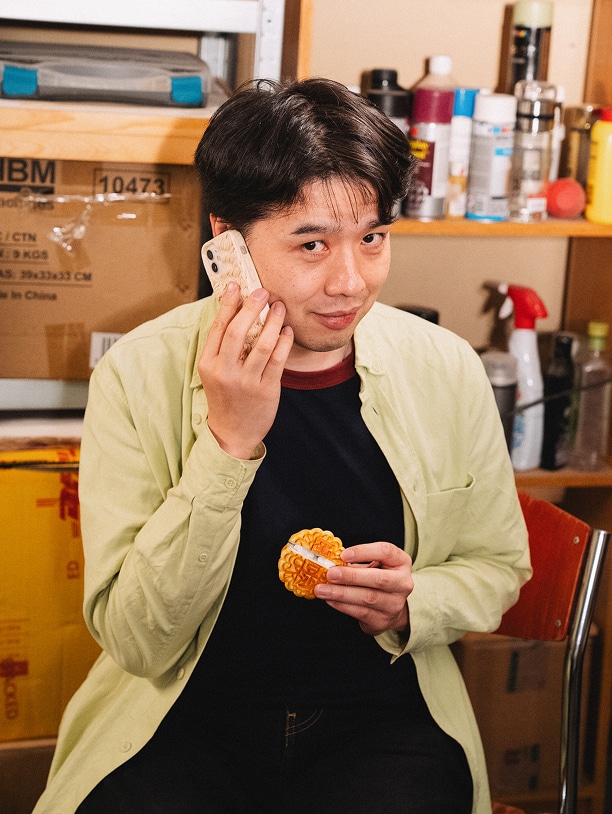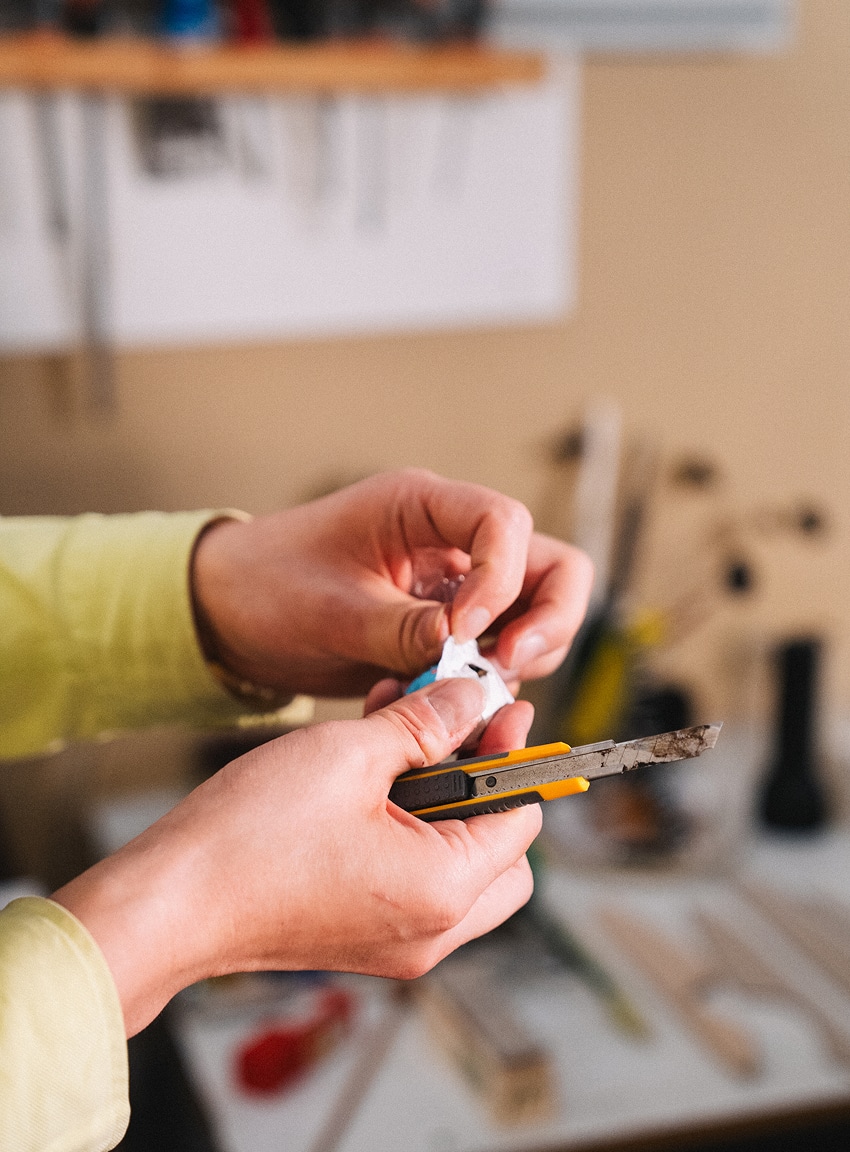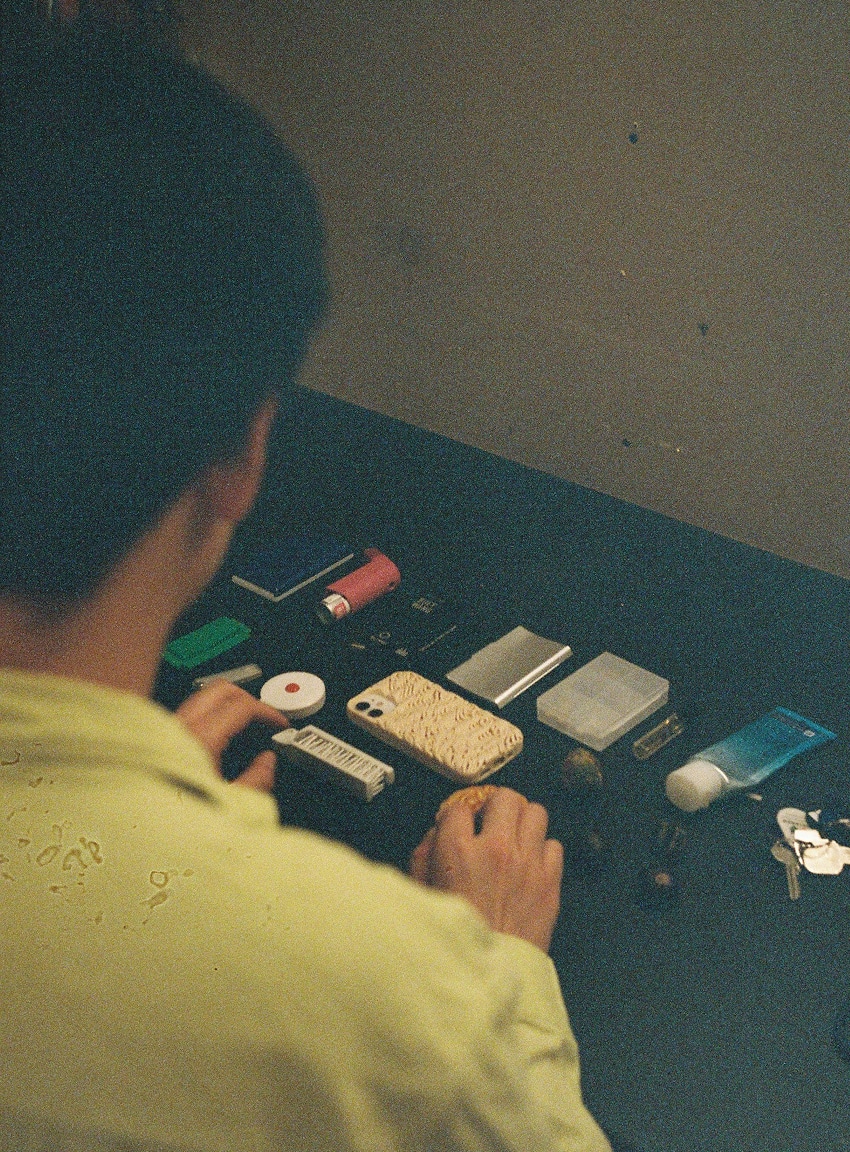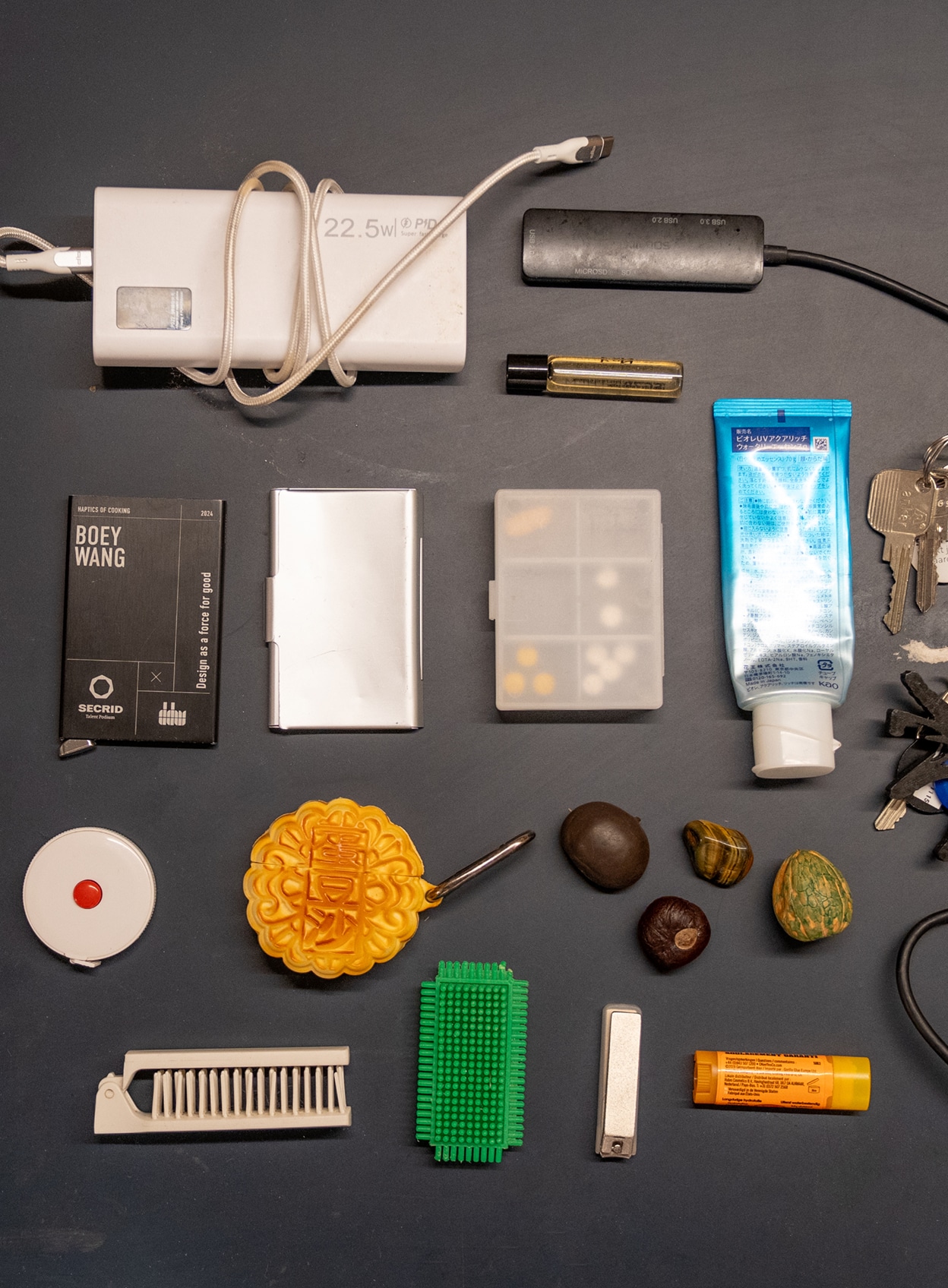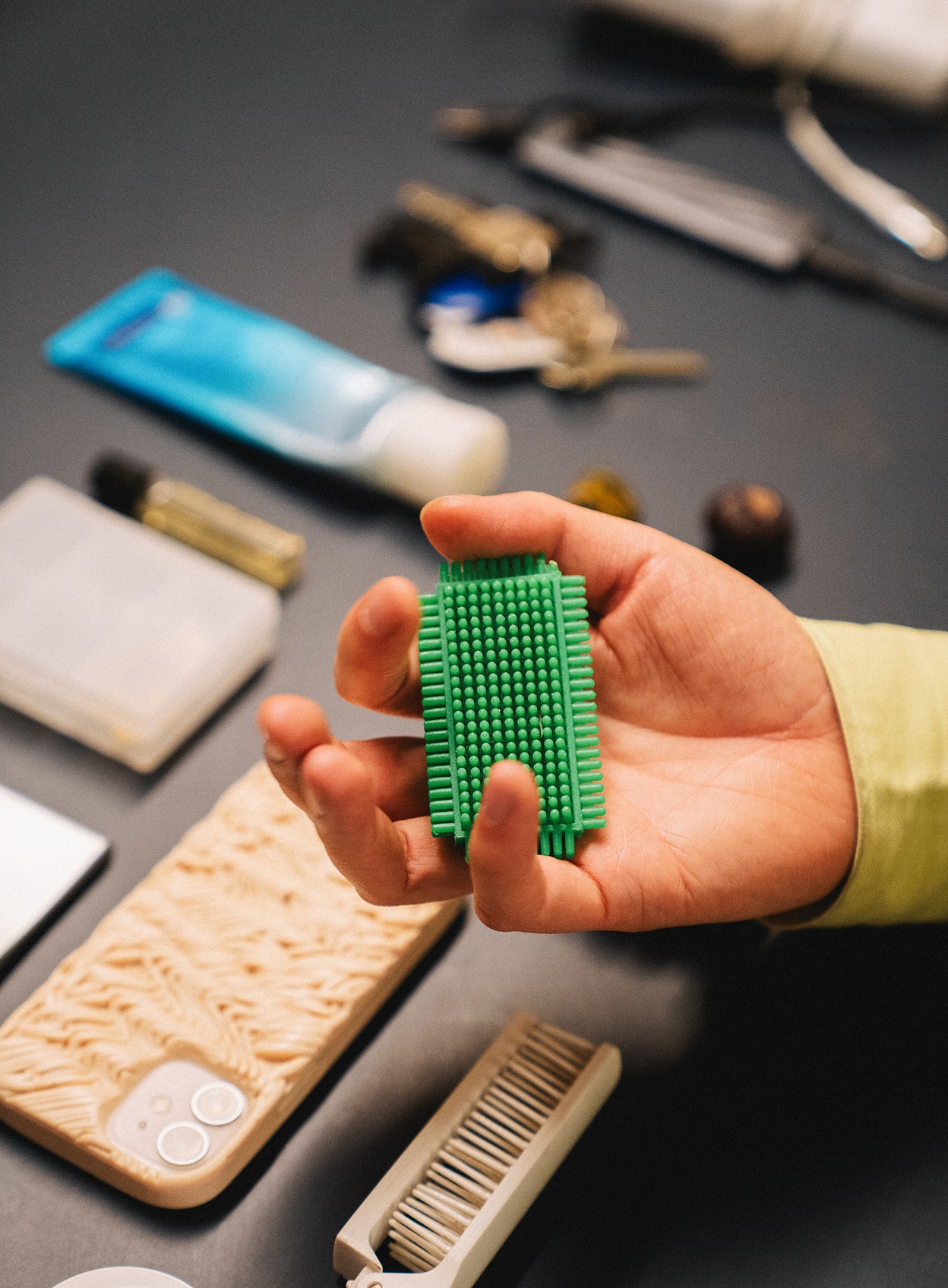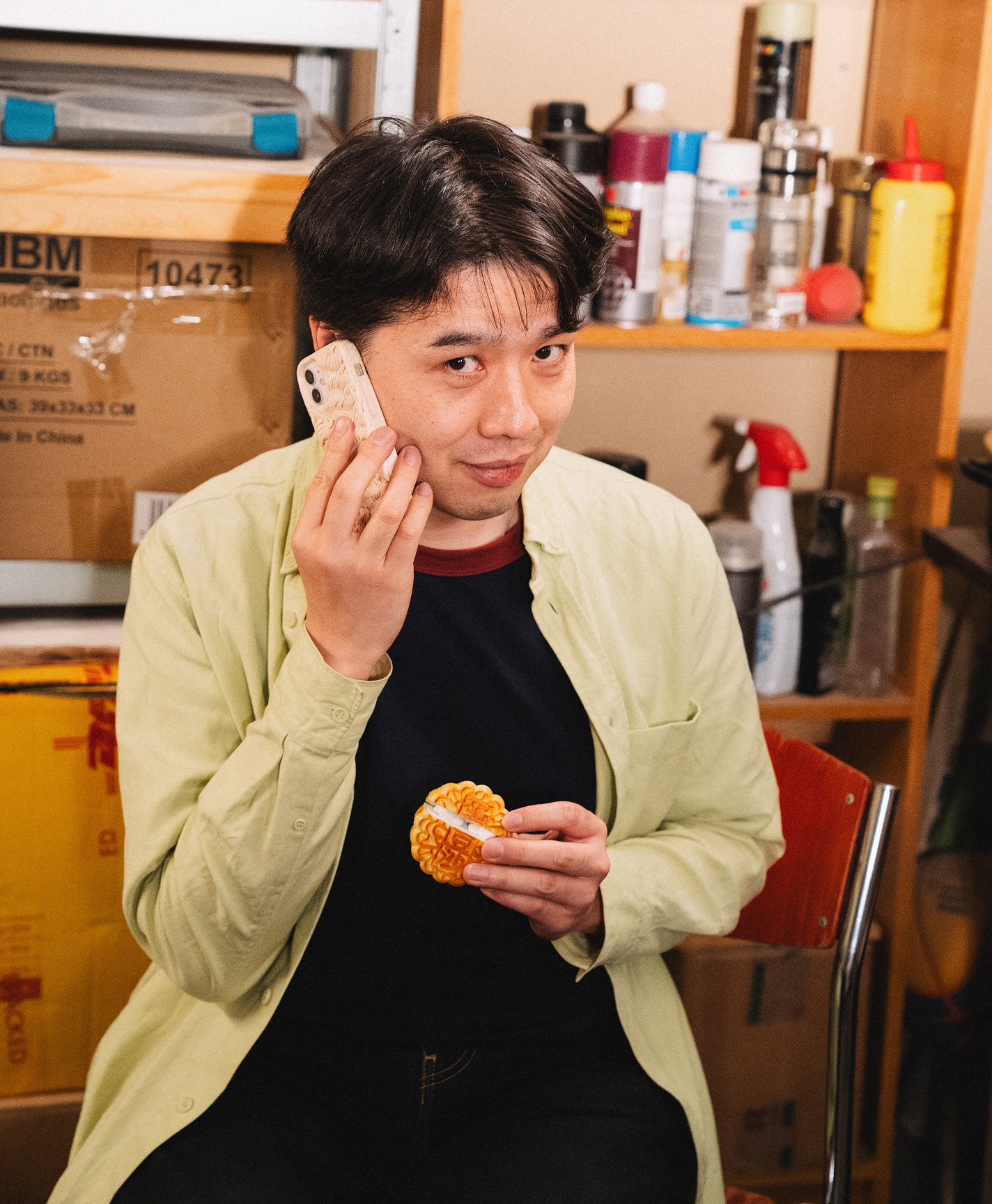
What’s In Your Pocket Says More Than You Think
Designer Boey on why pocketwear should be tactile, inclusive and personalized.
When we met Boey, he greeted us with pockets full, literally. A heavy keychain designed to make a sound when it hits the ground. A noodle-shaped phone case that doubles as a tribute to his Northern Chinese heritage and childhood. A compact brush for smoothing windblown hair after biking across Eindhoven. It might seem whimsical, random even. But as Boey begins to explain, each object is chosen with intention.
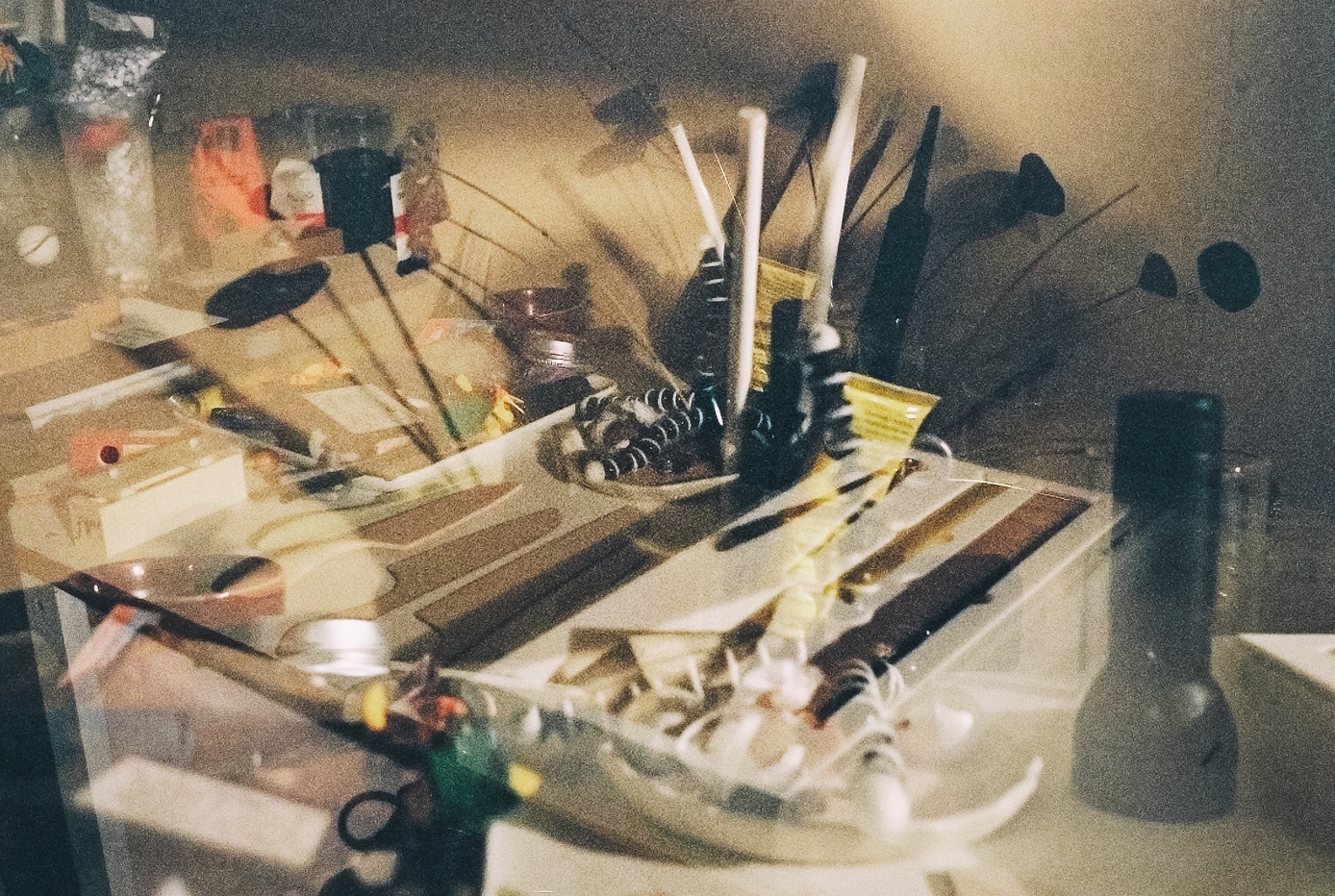
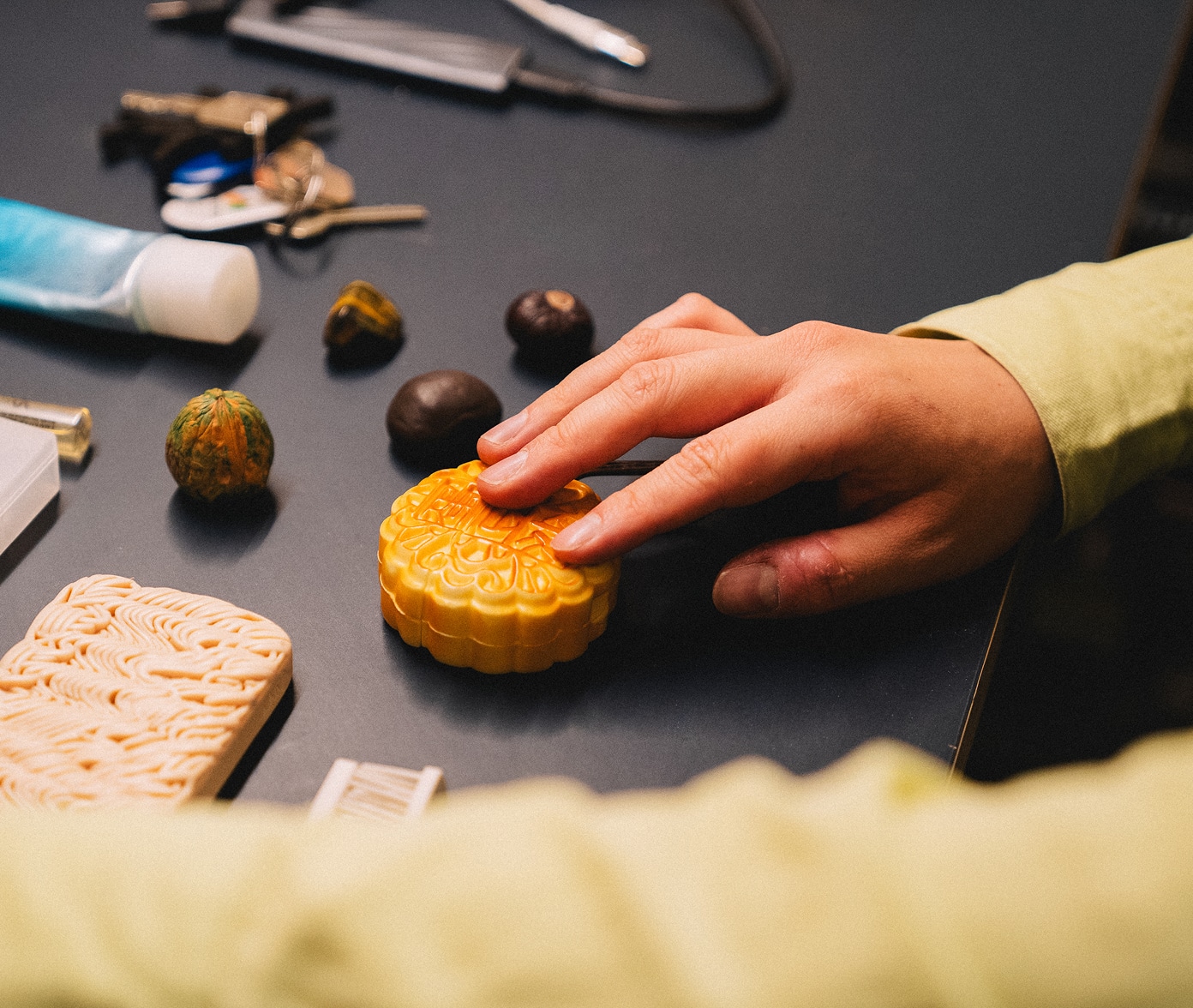
What happens when you think of a pocket not as storage, but as a space?
Boey has built a practice around tactile, inclusive kitchen tools. Objects that are as intuitive for blind users as they are beautiful to everyone. He’s become an expert at designing with the body, not just the eyes. So when we invited him to reflect on the concept of pocketwear, something clicked.
He admits, he hadn’t considered the pocket as a design space. But the more he thought about it, the more it made sense. The pocket, he explains, is where design meets mystery. Where everything is used without being seen. It’s a place where, according to Boey, function, integrity, inclusivity, sensory elements, and even social, emotional, and identity aspects come together. It's a design that lives close to the body. And maybe even closer to who we are.
What can your hands tell you that your eyes can’t?
Sight may dominate most product design today. But Boey invites us to shift focus. What if we let the hands lead? What if tactility, not visual polish, became our design baseline? An equally intelligent and often more honest way of navigating the world.
“Your hand is so honest,” he explained.
“If it’s nice, you know. If it’s not, you also recognise it immediately. It’s very direct... although you don’t see it”.
Boey’s insights comes from years of working and designing with people with limited or no vision. He describes how a simple object like a key, something most of us take for granted- can become a barrier. “They’re just flat metal pieces,” he said. “For someone who’s blind, the resolution of the fingers is everything. A rounded edge, a notch, a texture, these small cues make all the difference”.
So what if, instead of solving everything visually, we started solving things sensorially? What if we trusted touch to guide design?
This is where Boey sees real design potential. “The tactile functions we often solve visually,” he said. “But they can and should be solved by the hands.”
Inclusive design is successful when it doesn’t need to be explained.
Designing for Inclusion, invisibly
What makes Boey’s design philosophy so compelling is how natural his approach to inclusivity is. He doesn’t position it as an add-on or a charity. Instead, it’s woven into how he thinks. For him, inclusive design is successful when it doesn’t need to be explained.
The pocket, in that sense, is already a quietly inclusive space. We reach into it without looking. We navigate it by feel. In that way, it mirrors how many people with impairments move through the world every day.
But the objects within those pockets? But the objects inside those pockets? Those still often exclude.
Boey doesn’t believe the answer lies in special tools for specific users. Instead, he imagines design that simply works, for anyone. A texture that signals purpose. A wallet that reveals its contents through touch. A clasp that clicks in a way that feels unmistakable.
True inclusion, in his view, isn’t about creating separate solutions. It’s about removing the need to separate in the first place.
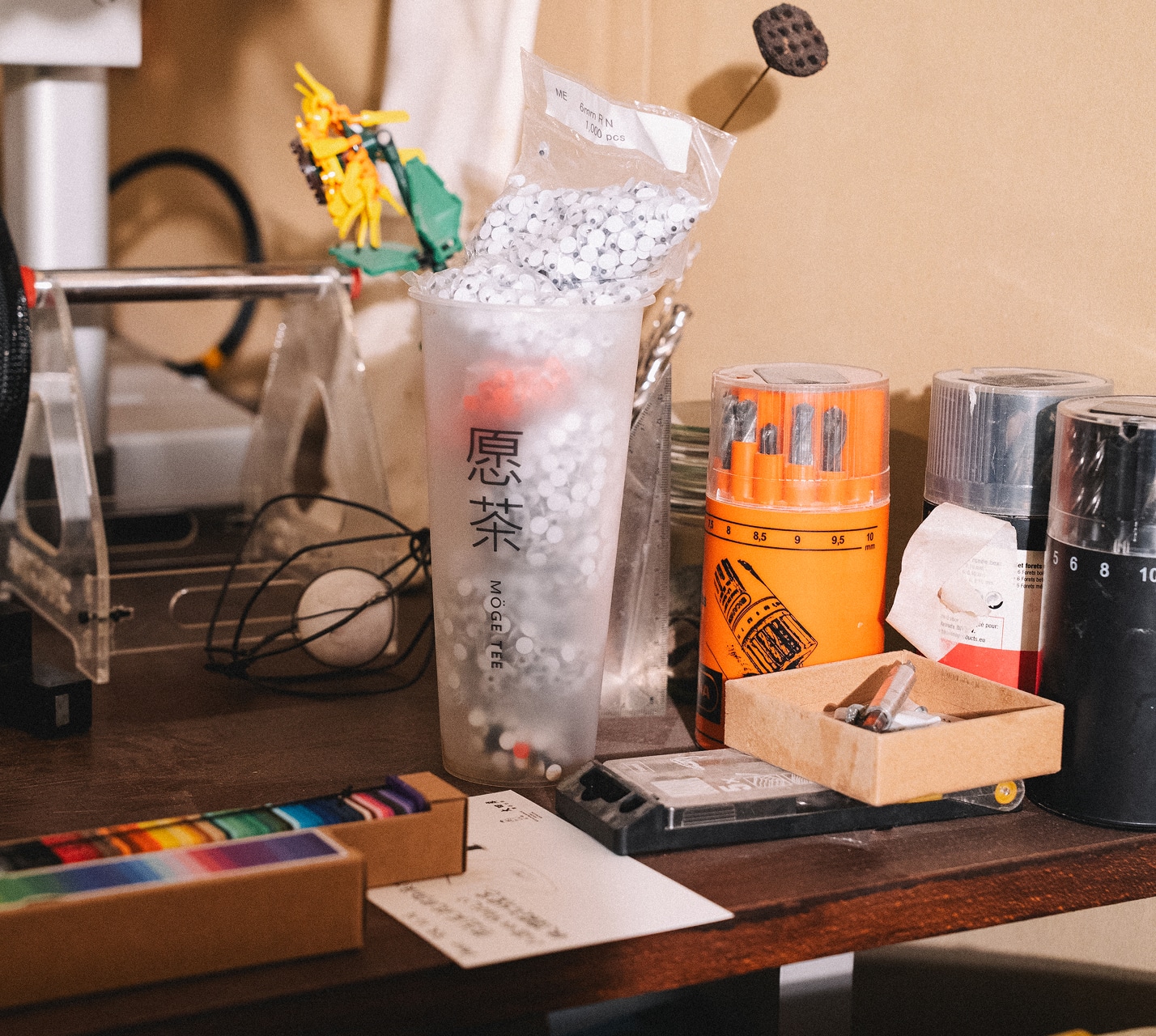
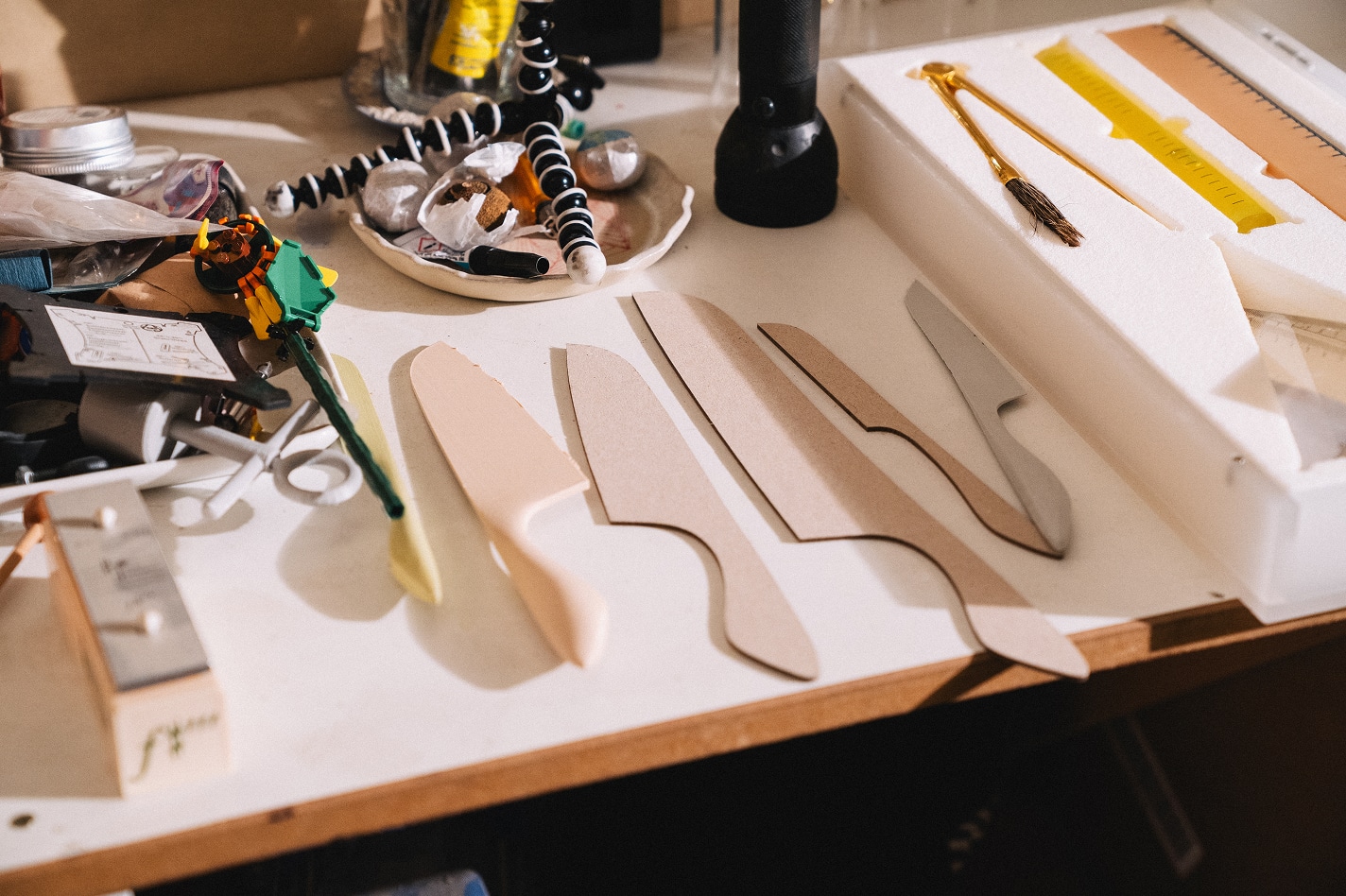
The Pocket as a Space for Personality
Where tactility offers clarity, personalization offers connection. For Boey, a pocket is more than a container. It’s a personal stage. Practical, yes, but also emotional. It’s close to the body, often hidden, and filled with small objects that carry meaning: tools, memories, habits. “There’s always a story in the pocket,” he said.
What do we choose to carry, and why?
What do those objects say about who we are or who we want to be?
A brush. A measuring tape. A nail clipper. Small tools, ordinary to most, but chosen with purpose. For Boey, they represent readiness. A kind of quiet pride. “We carry things that help us feel ready,” he reflected. “A Swiss knife, an inhaler, a tool. And when we pull it out at the right time, it becomes a proud moment. “Look, I have something for this.”
That’s the emotional side of Pocketwear. Not just what you carry, but why you carry it. It’s a performance of preparedness, identity, even memory.
A future you can feel: Back to the body
When we asked Boey about the future of Pocketwear, he saw two clear paths. “One is the high-tech version: putting batteries, sensors, tracking in everything. The other is more personal, more sensory, more emotional”.
He leans towards the second one.
“We already cram too much into our pockets,” he said. “It becomes a chaotic multi-tool, like a joke from a movie. What we need is clarity, not complexity.”
What would it mean to make fewer objects but better ones? To create pocketwear that’s expressive, useful, and intuitive, not overloaded?
What Boey imagines instead is a refined future: Pocketwear that’s compact but expressive, useful but intuitive. A layered space where function, touch, and personality are blended into one. Not a digital solution to everything, but a tactile one that just works and where people can put their own identity into it. At the end pockets are more than storage. It’s a space of intimacy, instinct, and identity.
The tactile functions we often solve visually, but they can and should be solved by the hands.
The drop that matters
Before we wrapped our conversation, we asked Boey if there was something he wished existed. Something we don’t yet have for our pockets. His answer: something that helps us not lose things.
“For blind people, dropping keys is dramatic. It’s basically losing them forever,” he said. “So something that tells you where they fall, that would help a lot”.
Not flashy. Not futuristic. Just thoughtful.
And that’s Boey’s point, really.
Good design doesn’t need to shout.
It just needs to do what matters; with thoughtfulness and care.
More Interviews

PulpaTronics
PulpaTronics is developing fully recyclable RFID tags made from paper – to replace metal antennas that are typically hidden in price tags, hotel key cards, and packaging labels.

Circle Farming
Circle Farming is developing an agricultural method with circular fields that combine efficiency and sustainability.

Respyre
Respyre is developing moss concrete: an innovative building material where living mosses grow on concrete facades.

Carbon Cell
Carbon Cell’s foam is carbon-negative, plastic-free, compostable, and affordable—basically a game-changer for packaging

Bolt by Clip
BOLT, a solution created by CLIP, is the world’s most affordable plug-and-play device for turning any bicycle into an e-bike.

Papilio by Tobias Trübenbacher
PAPILIO is an innovative wind-powered streetlight that reduces light pollution and enhances the aesthetic appeal of its surroundings
